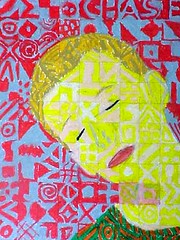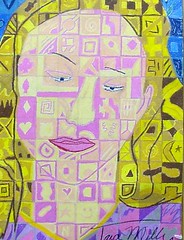In 1988, Close’s style changed. He suffered a spinal blood clot and became a quadriplegic. He became unable to control his tools with as much detail as he could before, so he had to adapt his painting style. Using a special holster on his wrist to hold a brush he learned to paint a new kind of portrait. Instead of photorealistic work, his paintings are now representational and are based more on pointillism. He still treats the sections of the grid individually, but they are less detailed. Each section has separate colors that blend visually when a viewer steps back from the painting."
This is from a handout I found at Waunakee Community School . I knew that Close was in a wheelchair, but I had no idea what kind of obstacles he had overcome to keep working. He initially painted with his teeth and then recovered some movement in his arm.
The handout also has instructions for kids to do a Chuck Close-inspired self portrait (or anyone! I did one and had so much fun - I'm going to help my girls do one this next week). The students used oil pastels to complete their drawings, but you could also use acrylic paints, colored pencil, even crayons.
Here are some examples of the students' work:


See More Examples. Project Instructions:
For this assignment, you will be creating a self-portrait based on Close’s later work. As a class you will take digital photos of one another. You will learn how to grid the photo and your paper so you are able to enlarge your portrait. Once you have sketched in the proportions of your face (using the grid for accuracy), you will begin filling in each box using bright colors and designs.
Please follow the guidelines below for a successful project.

 more on chuck close: grid painting
more on chuck close: grid painting













































